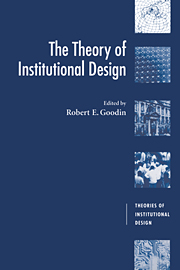Book contents
- Frontmatter
- Contents
- Notes on Contributors
- Preface
- 1 Institutions and Their Design
- 2 Institutional Design and Rational Choice
- 3 Second Best Theories and the Implications for Institutional Design
- 4 The Informal Logic of Institutional Design
- 5 Institutional Morality
- 6 The Publicity Principle
- 7 Designing Institutions in East European Transitions
- 8 Political Deals in Institutional Settings
- 9 Self-inventing Institutions: Institutional Design and the U.K. Welfare State
- 10 Selection and the Currency of Reward
- Name Index
- Subject Index
1 - Institutions and Their Design
Published online by Cambridge University Press: 05 August 2012
- Frontmatter
- Contents
- Notes on Contributors
- Preface
- 1 Institutions and Their Design
- 2 Institutional Design and Rational Choice
- 3 Second Best Theories and the Implications for Institutional Design
- 4 The Informal Logic of Institutional Design
- 5 Institutional Morality
- 6 The Publicity Principle
- 7 Designing Institutions in East European Transitions
- 8 Political Deals in Institutional Settings
- 9 Self-inventing Institutions: Institutional Design and the U.K. Welfare State
- 10 Selection and the Currency of Reward
- Name Index
- Subject Index
Summary
The principal aim of this introduction is to sketch the contours of the existing literature as it touches upon theories of institutional design. It will situate the contributions of the present collection as well as map the domain of the larger series within which this collection is set.
The chapter starts by tracing continuities and discontinuities in the study of institutions, in the first instance, on a discipline-by-discipline basis. I avoid prematurely and preemptorily defining the term “institution,” preferring instead to let each discipline speak with its own voice. Inevitably, each discipline (and indeed subdiscipline) focuses on different institutions as paradigmatic and picks out different characteristics as their defining features. I propose to harness rather than straightjacket this diversity. Once I have let all these disparate disciplines have their say in their own ways, all of them will then be consolidated into a few broader reflections upon the form and function of social institutions. As part of that, I identify a minimalist definition of “institutions” upon which most institutionalists, old and new and across a range of disciplines, can broadly agree.
That analysis provides a platform from which to address, in the final two sections, questions about the perfectability of social institutions. Key questions there concern the extent to which institutions accidentally emerge or automatically evolve, and the extent to which they are subject to intentional design and redesign. Insofar as intentional (re)design of some sort or another is a feasible aspiration in any sense at all, further questions arise about what sorts of principles, both normative and empirical, might properly be employed in those endeavors.
- Type
- Chapter
- Information
- The Theory of Institutional Design , pp. 1 - 53Publisher: Cambridge University PressPrint publication year: 1996
- 110
- Cited by



